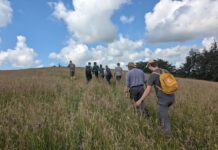
A new report seems to reveal that Ecoacoustic Bird Survey (EBS) methods increase the detection of bird species, and should be used in combination with Traditional Bird Surveys (TBS).
It was published by ecology consultancy Baker Consultants on Applied Ecology Resources (AER), an open platform for sharing information run by the British Ecological Society.
Several methods are currently used in the UK to undertake bird surveys, most notably TBS methods, which involve aural and visual detections undertaken by an experienced ornithologist. These comprise fieldwork conducted according to predetermined methodologies, including point counts, line transects, and breeding bird surveys.
However, though these methods produce accurate, targeted data, they are often difficult to conduct at night or in remote locations, and survey duration is restricted by human capacity. Birds can also be impacted by surveyor presence and there is often no verifiable evidence for the species seen or heard in the field.
Ecoacoustics is a rapidly developing method of wildlife monitoring; by incorporating this into bird survey methods, researchers can expand the spatial and temporal coverage of data collection via specialised equipment to monitor bird sounds. This enables researchers to increase the detection of bird species.
Carlos Abrahams, Director of Ecoacoustics at Baker Consultants, explained: “Ecoacoustic bird survey methods are highly complementary to traditional bird surveys, which are better suited to detecting bird behaviour and movements through a site. But it’s important to stress that our research indicates ecoacoustic surveys should not be casually used as ad hoc additions to traditional surveys; EBS methods are most effective when survey effort is appropriately robust.”
With the most recent State of Nature Report 2023 revealing that one in six species and 43% of bird species in Great Britain are at risk of extinction, a more comprehensive and robust assessment of sites is integral to better biodiversity monitoring. Ecoacoustic monitoring programmes can be used to successfully inform long-term, sustainable conservation that can help reverse the rapid and drastic loss of diversity we have witnessed.
“Adhering to published guidance is so important to the reliability, consistency, and comparability of ecoacoustic surveys. We recommend that the two survey approaches, traditional and ecoacoustic, should be used alongside each other within professional practice to provide a more comprehensive assessment of sites for EIA or habitat management,” Abrahams adds.
Scientific studies have demonstrated that automated EBS methods can outperform point count methods. However, there have been no studies that compare the results of EBS with the transect surveys as normally used for EIA in the UK.
The report is hosted on Applied Ecology Resources (AER), the British Ecological Society’s new open-access platform. It enables organisations, scientists and practitioners working across research and practice to pool their knowledge around ecological science within a permanent, secure and fully searchable space. AER is home to both peer reviewed and non-peer reviewed reports, data reports, research summaries and other grey literature, all of which is publicly accessible.
Marc Cadotte, Editor-in-Chief of AER, commented: “Baker Consultants’ most recent white paper on ecoacoustic bird surveys presents a positive vision of how technology can be used to enhance biodiversity monitoring. Learning from past surveys is also integral to more informed decision-making which is why consistency in methods is so important.
The full report on ecoacoustic bird surveys can be viewed on AER here.
Further best practice guidance on long-term ecoacoustic monitoring in the UK is also available. Baker Consultants has also used the findings from the white paper to develop the acoustic survey section of the standard Bird Survey Guidelines: https://birdsurveyguidelines.org/acoustic-survey-methods/








